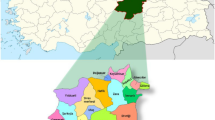Abstract
The snake melon, Cucumis melo subsp. melo Flexuosus Group, is a cucurbit crop that was grown and esteemed in Mediterranean lands in antiquity and classical times. Images of snake melons appear in ancient Egyptian wall paintings and sculptures and in mosaics from the Roman Empire. The sikyos of Greek, the cucumis of Latin, and the qishu’im of Hebrew, thought by many to be cucumbers, Cucumis sativus, have now been identified as snake melons. Less iconographic and written evidence exists concerning the appreciation of snake melons during the medieval period. The present work focuses on some philologically based evidence of the importance of snake melons leading into and including the medieval period, with two specific objectives. One was to trace the records of the Hebrew epithet piqqus, which applied to removal of the hairs of young cucurbit fruits, and the Arabic epithet faqqous, used historically and to the present day to designate snake melons. Another objective was to re-affirm how piqqus was actually conducted, as mandated in the second-century code of Jewish Oral Law known as the Mishna. Various conjugational forms of the Hebrew word piqqus were found in writings dating from 200 CE to approximately 600 CE. Evidence is presented that further establishes the exact meaning of piqqus as the rubbing off of the hairs of young cucurbit fruits. The Arabic word faqqous was found in writings dating from the beginning of the tenth century and through to the end of the medieval period in the fifteenth century, the writers hailing from Andalusia in the west to Iraq in the east. These writings suggest that the snake melon was a familiar vegetable across a wide geographic belt throughout the medieval period.

Similar content being viewed by others
References
Anqori Z (1966) Eliyyahu Beshaychi: Adderet Eliyyahu. HaMo‘aza ha’Arzit shel ‘Adat haYehudim haQara’im beYisra’el, Ramla (Israel)
Ar-Razi M (1982) Manafi‘ al-aghdhiya wa-daf‘ madarriha [Treatise on foods and correctives]. Dar Ihya al-‘Ulum, Beirut, p 229
Burger Y, Sa‘ar U, Paris HS, Lewinsohn E, Katzir N, Tadmor Y, Schaffer AA (2006) Genetic variability for valuable fruit quality traits in Cucumis melo. Israel J Plant Sci 54:233–242
Burger Y, Paris HS, Cohen R, Katzir N, Tadmor Y, Lewinsohn E, Schaffer AA (2010) Genetic diversity of Cucumis melo. Hort Revs 36:165–198, 4 pl. Wiley, New York
Chakravarty HL (1966) Monograph of the Cucurbitaceae of Iraq. Tech Bull 133, Ministry of Agriculture, Baghdad, pp 90–91
Clément-Mullet J-J (1866) Le livre de l’agriculture d’ibn-Al-Awam, vol 2. A. Franck, Paris, pp 205–206
De Sacy S (transl., comm.) (1810) Relation de l’Égypte par Abd-Allatif, médecin arabe de Bagdad. Imprimerie Impériale, Paris, pp 34–35
Fallik E, Aharoni Y, Copel A, Rodov V, Tuvia-Alkalai S, Horev B, Yekutieli O, Wiseblum A, Regev R (2000) Reduction of postharvest losses of Galia melon by a short hot-water rinse. Plant Pathol 49:333–338
Feliks J (1967) Kil’e zera‘im weharkava, massekhet kil’ayim [Seed crossing and grafting]. Devir, Tel Aviv (Hebrew), p 49
Feliks J (2005) Talmud Yerushalmi massekhet ma‘asrot, perush uvi’ur. [The Jerusalem Talmud tractate ma‘asrot, annotated critical edition.]. Bar-Ilan University Press, Ramat Gan, Israel (Hebrew), pp 64–65
Forster ES, Heffner EH (1955) Lucius Junius Moderatus Columella: on agriculture 10–12. Harvard University Press, Cambridge, MA, pp 26–27, 40–43, 159–163
Goldman A (2002) Melons for the passionate grower. Artisan, New York, pp 24–25, 36, 112–114
Hamidullah M (1973) Le dictionnaire botanique d’Abu Hanifa ad-Dinawari: kitab an-nabat, de sin à ya. Institut Français d’Archéologie Orientale, Cairo, p 199
Hamidullah M (1993) The book of plants by Abu Hanifa Al-Dinawari. Bayt al-Hikmat, Karachi, p 528
Hammer K, Hanelt P, Perrino P (1986) Carosello and the taxonomy of Cucumis melo L. especially of its vegetable races. Kulturpflanze 34:249–259
Hassib M (1938) Cucurbitaceae in Egypt. Noury & Fils, Cairo, pp 83–97
Issa Bey A (1930) Dictionnaire des noms des plantes. Imprimerie Nationale, Cairo, pp 61–62
Janick J, Paris HS, Parrish DC (2007) The cucurbits of Mediterranean antiquity: identification of taxa from ancient images and descriptions. Ann Bot 100:1441–1457
Jeffrey C (2001) Cucurbitaceae. In: Hanelt P, Inst. Plant Genet, Crop Plant Res. (eds) Mansfeld’s encyclopedia of agricultural and horticultural crops. Springer, Berlin, pp 1541–1552
Keimer L (1924) Die Gartenpflanzen im alten Ägypten. Hoffmann & Campe, Hamburg, pp 12–18, 84–87, 170–171, 181
Kirkbride JH Jr (1993) Biosystematic monograph of the genus Cucumis (Cucurbitaceae). Parkway, Boone, NC, pp 1, 80
Kraemer JL (2008) Maimonides: the life and world of one of civilization’s greatest minds. Doubleday, New York, pp 164–166, 316–319, 456
Laghetti G, Accogli R, Hammer K (2008) Different cucumber melon (Cucumis melo L.) races cultivated in Salento (Italy). Genet Resour Crop Evol 55:619–623
Leclerc L (1883) Traité des simples par Ibn El-Beïthar, vol 3. Imprimerie Nationale, Paris, p 39
Lewin B (1960) The third part of the Kitab al-Nabat of Abu Hanifa ad-Dinawari. Orientalia Suecana 9:131–136
Lieberman S (1955) Tosefta kifshuta. Jewish Theological Seminary of America, New York, pp 666–672
Luncz AM (ed) (1897) Caftor va-pherach par Estori ha-Parchi, 3rd edn. A.M. Luncz, Jerusalem, p 742
Manniche L (1989) An ancient Egyptian herbal. University of Texas Press, Austin, pp 91–96
Marin M, Waines D (eds) (1993) Kanz al-fawa’id fi tanwi‘ al-mawa’id. Franz Steiner, Stuttgart
Mekhon Mamre (2010) www.mechon-mamre.org. Accessed 22 Oct 2010
Meyerhof M (1940) Šarh asma al-‘uqqar, l’explication des noms des drogues, un glossaire de matière médicale composé par Maimonide. Institut Français d’Archéologie Orientale, Cairo, pp 171–172
Meyerhof M, Sobhy GP (1932) The abridged version of “The Book of Simple Drugs” of Ahmad ibn Muhammad al-Ghafiqi. vol 1, Fasc. 1. Al-Ettemad, Cairo
Millas JM Aziman M (1955) Ibn Bassal, Libro de agricultura. Instituto Muley El-Hasan, Tetuan, pp 165–166 (Sp.), 127–128 (Ar.)
Mohamed ETI, Yousif MT (2004) Indigenous melons (Cucumis melo L.) in Sudan: a review of their genetic resources and prospects for use as sources of disease and insect resistance. Plant Genet Resourc Newsl 138:36–42
Nasrallah N (2007) Annals of the caliph’s kitchens, Ibn Sayyar al-Warraq’s tenth-century Baghdadi cookbook. E. J. Brill, Leiden, p 168
Pandey S, Dhillon NPS, Sureja AK, Singh D, Malik AA (2010) Hybridization for increased yield and nutritional content of snake melon (Cucumis melo L. var. flexuosus). Plant Genet Resour 8:127–131
Paris HS (1989) Historical records, origins, and development of the edible cultivar groups of Cucurbita pepo (Cucurbitaceae). Econ Bot 43:423–443
Paris HS (2009) Faqqous: a melon that resembles cucumber—an ancient crop in Israel. Haqla’e Yisra’el 39:65–66 (Hebrew)
Paris HS, Janick J (2008a) Reflections on linguistics as an aid to taxonomical identification of ancient Mediterranean cucurbits: the piqqus of the faqqous. In: Pitrat M (ed) Cucurbitaceae 2008. I.N.R.A, Avignon, France, pp 43–51
Paris HS, Janick J (2008b) What the Emperor Tiberius grew in his greenhouses. In: Pitrat M (ed) Cucurbitaceae 2008. I.N.R.A, Avignon, France, pp 33–41
Pitrat M, Hanelt P, Hammer K (2000) Some comments on infraspecific classification of cultivars of melon. In: Katzir N, Paris HS (eds) Proceedings of Cucurbitaceae 2000, the 7th Eucarpia Meeting on Cucurbit Genetics and Breeding. Acta Hort 510:29–36
Qafah Y (1963, 1968) Mishna ‘im perush rabbenu Moshe Ben-Maymon, maqor wetirgum. [Maimonides’ Commentary on the Mishna, original and translation.] vol 1, Order Zera‘im and vol 6 (part 2), Order Tohorot. Mossad Harav Kook, Jerusalem
Rackham H (1950) Pliny natural history, vol 5. Harvard University Press, Cambridge, pp 460–469
Rosner F (transl., annot.) (1995) Šarh asma al-‘uqqar, glossary of drug names. Maimonides Research Institute, Haifa, p 270
Sebastian P, Schaefer H, Telford IRH, Renner SS (2010) Cucumber (Cucumis sativus) and melon (C. melo) have numerous wild relatives in Asia and Australia, and the sister species of melon is from Australia. Proc Natl Acad Sci USA 107:14269–14273
Walters TW, Thieret JW (1993) The snake melon (Cucumis melo; Cucurbitaceae). Econ Bot 47:99–100
Zohary D, Hopf M (1993) Domestication of plants in the Old World. Clarendon Press, Oxford, pp 182–183
Acknowledgments
I am grateful to the Haifa University Library, Haifa, Israel for access to its fine, extensive collection of medieval Semitic literature. This research was supported in part by a grant from the Lillian Goldman Charitable Trust (New York).
Author information
Authors and Affiliations
Corresponding author
Rights and permissions
About this article
Cite this article
Paris, H.S. Semitic-language records of snake melons (Cucumis melo, Cucurbitaceae) in the medieval period and the “piqqus” of the “faqqous”. Genet Resour Crop Evol 59, 31–38 (2012). https://doi.org/10.1007/s10722-011-9664-y
Received:
Accepted:
Published:
Issue Date:
DOI: https://doi.org/10.1007/s10722-011-9664-y




